By Professor Gloria Moss PhD, Off-Guardian.org
It is now 353 years since the Great Fire of London, a fire that caused the destruction of 436 acres of London including 13,200 houses, 87 parish churches (out of 109), St Paul’s Cathedral, and most of the buildings of the City authorities. In all, it is estimated that around 100,000 people, one-third of London’s population, were made homeless since the start of the five-day fire on 2 September.
THE OFFICIAL STORY
It is widely held that the fire started in Pudding Lane (see illustration 1) in the bakery of Thomas Farriner, provider of the bread for the Royal Navy’s nearby Victualing Office. Negligence was held out as a primary factor despite Farriner’s subsequent assurances that at midnight, a few hours before the fire broke out, only one grate had any smouldering embers and these had all been raked over. He claimed, moreover, that he had gone through every room in the bakery after midnight and that all the doors and windows had been closed to prevent draughts.
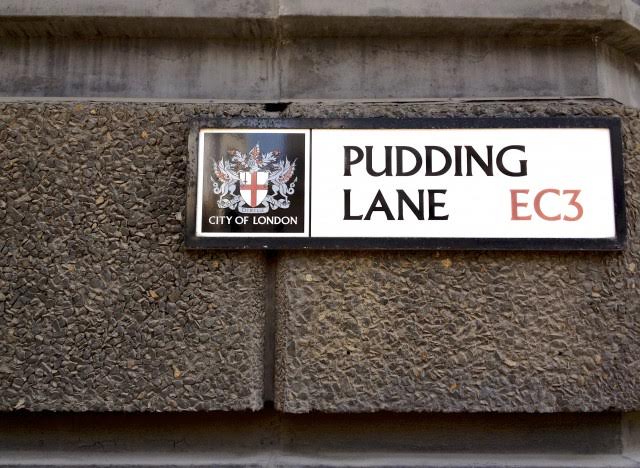
Illustration 1 – Pudding Lane
So, is there more to this story than meets the eye? Farriner maintained his innocence until his death in 1670 swearing-in court that his house could only have been set alight maliciously. For the first time, we ask what evidence there is to support his claim, suggesting in fact that the balance of probability lies in his favour. A word first about the responsibilities for fire fighting at the time.
FIRE-FIGHTING
Responsibility for putting out fires lay with streets, parish or wards and preventative measures included pulling down buildings, dislodging the superstructure from its foundations and causing the framework to collapse. This approach will have been known to the authorities in London but the authority of the Mayor of London was needed before this could be done.
Unfortunately, the then post-holder, Thomas Bloodworth, was the man who declared that the fire was so small, ‘a woman might piss it out’ and so forcible demolition of buildings was not used until the third day of the fire when it had already spread extensively. Note also that Bloodworth declined the supply of additional soldiers on the first day of the fire.
Beyond the Mayor, responsibility for fighting fires lay with men at fire posts throughout the City but on the first day of the fire, 2 September, the diarist and clerk of the Privy Seal, Samuel Pepys, noted ‘nobody to my sight endeavouring to quench it’, remarking that the Mayor of London had stated that he needed no more soldiers to help with the fire (Milne, 1986, p.31). Why would he take that view?
Meanwhile, Thomas Vincent, the puritan minister, noted on 3 September how the wood removed from houses had been placed in the spacious and fashionable shopping area of Cornhill, towards the north of the city, but had not been removed from there, allowing the wood to catch fire. Likewise, on the third day of the fire, 5 September, the diarist, John Evelyn noted how the Gentlemen ‘began to bestir themselves, and not till now, who had stood as men interdict, with their hands a cross’. Then, on Thursday 6 September, many of the constables who should have been at fire posts were reported as absent by the Earl of Oxford, then undertaking a check. So, at best, the lack of action was a case of poor organisation and at worst purposeful negligence.
ACT OF NATURE OR A MALIGN PLOT?
What of the claim that the fire was started and spread maliciously? Although this way of thinking has been sidelines as evidence of a ‘plot mentality’ (Marshall, 2016), there is much to cause disquiet in the official story. We will focus on four points which suggest that the fire was no accident.
Fires common at the time
If the conflagration really had developed from a single fire in a building in Pudding Lane, it is perplexing – without other credible factors at play – that it could have spread so rapidly across the City of London. Indeed, the very relaxed attitude of contemporaries suggests firstly that fires were not untoward and secondly, not likely to spread.
For example, Pepys, on being informed of the fire at three in the morning on 2 September, and seeing it from his window, thought it ‘far enough off’ to justify going to bed.
Indeed, ‘fires were common’ at the time (McRobbie, 2016), explaining why the London Gazette, the city’s twice-weekly newspaper, ran a small item about the fire in its Monday edition, among gossip about the Prince of Saxe’s unconsummated marriage to the Princess of Denmark and news of a storm in the English Channel. So, Pepys had no particular reason for suspecting that the fire would be other than a small, local one, writing specifically that he was ‘unused to such fires as followed’ so had no reason to imagine that the fire would spark a major conflagration.
Drought and timber structures
What arguments do those who do not suspect any malfeasance use? Very often, they cite the fact that the summer had been hot and dry and, as one commentator put it, the ‘houses creaked with dry joints’. However, the combination of these two points do not immediately explain the extent of the fire since a major fire had occurred in 1633, also a time of drought (see weatherwebdotnet) but this fire destroyed no more than 122 buildings, 42 at the northern end of London Bridge and 80 on Thames Street. This figure that compares with the 300 buildings burned down in 1666 in the space of the first morning alone.
So, the conditions normally cited as causing the Great Fire (ie the hot weather and the timber frames of the buildings) cannot on their own explain the fiendish nature of the fire in 1666.
The wind
In reality, this was unlike other fires since all attempts to create firebreaks were in vain and the fire even leaped the river Fleet and the Thames down to Southwark. How could this be? Commentators past and present cite the strength of the wind blowing from the east with the British Library, for example, referencing ‘the dry weather and strong easterly wind’ as ‘creating the perfect conditions for the rapid spread of the fire’.
Likewise, the London Gazette of 8 September, offering what it claimed was a ‘true account of the fire’ (indeed the publication has been described by Jenner 2017 as offering the official account of the fire to its 13,000-15,000 readers) described how a ‘violent Easterly wind formented [the fire], and kept it burning all day, and the night following, spreading itself up to Grace-church street and downwards from Cannon Street to the Waterside as far as the Three Cranes’. The movement up to Grace-Church and Cannon street is in a northerly direction relative to Pudding Lane while that to the Waterside is to the south.
In point of fact, if you look at the way that the fire had spread in the course of the second day , you will see that it affected areas to the east and north of its starting point in Pudding Lane, whereas you would expect an easterly wind to restrict its spread to areas to the west of the starting point.

Illustration 2 – Map showing the spread of the fire
This is particularly strange since the direction of the easterly wind is said to have shifted only at 11pm on the third day at which point the fire moved towards the Tower of London. So how could the easterly wind have been responsible for the direction of a fire that headed north and south of Pudding Lane? (see illustration 2).
These anomalies did not go unremarked by contemporaries. Thomas Vincent, for example, referred to the ‘strange spreading of the fire’ on 2 September (Milne, 1986, p.35), stating how on 3 September the fire worked ‘fast against the wind’ (ibid, p.37) so that it ‘wrought backwards strangely against the wind’ moving its way eastwards to Tower Street (ibid, p.43.).
Likewise, John Evelyn described a ‘fierce, eastern wind’ but noted on 3 September the way in which the fire ‘kindled back against the wind as well as forward’ (ibid, p.41).
So, it seems that the presence of a strong easterly wind on the first two days of the fire cannot, on its own, explain the fire’s direction of travel.
Pitch
Among the burnt objects retrieved from a shop near Pudding Lane were melted pieces of pottery that revealed the effects of temperatures as high as 1700 degrees Celsius (Museum of London, p.1).
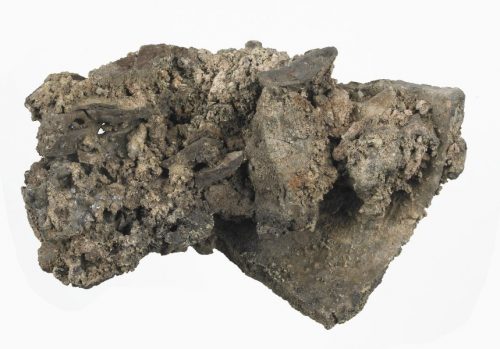
Illustration 3 – Melted pottery – evidence of extreme heat.
The Museum of London wrote (ibid) that pitch burns very easily and would have helped to spread the fire and certainly at temperatures such as these, the fire would have been enormously powerful. However, it is unlikely that without manufactured oxygen currents, as typically found in Firestorms, these high temperatures could have been produced.
WHERE DOES THIS LEAVE US?
Having examined the factors to which the Great Fire has been attributed – drought, timber structures, a strong easterly wind and burning pitch – it seems that these alone cannot explain the strength and reach of the Great Fire. We are forced into the inevitable conclusion that a fire in Pudding Lane and hot weather could not have been the sole causes of the Great Fire. So, in the section that follows, we investigate the evidence for a plot, ending with the question as to who may have benefited from this.
EVIDENCE OF A PLOT
The notion that the Great Fire was not an innocent one is recorded on the original inscription on the Monument building, constructed by Wren in the 1670s to commemorate the fire. Whilst this text was erased in 1830, the first words read:
In perpetual remembrance of the most dreadful burning of this protestant city, begun and carried on by the treachery and malice of the popish faction”
Plots were not uncommon and in fact people had been executed in April 1666 for a Papish plot intended go live in London on 3 September.
Indeed, many contemporary observers suspected foul play. Farriner, for example, the baker in Pudding Lane, concluded that ‘it was absolutely set fire on purpose’ (October Sessions of the Old Bailey, London 1666) and the puritan minister, Thomas Vincent, stated that there were rumours of fire balls being thrown to provoke the furious flames (Milne, 1986, p.30).
Moreover, on Tuesday 4 September, Vincent expressed surprise at the way that St Paul’s Cathedral, then the largest church in Britain and the third largest in Europe, had been affected by the fire. If you analyse what he said, there are no fewer than three main factors underlying his concern.
Firstly, where the construction of the building is concerned, he singled out the fact that the building was made of stone and that great beams and stones fell and ‘great flakes of stone scale[d] and peel[ed] off strangely from the sides of the walls.’
Then, in terms of its location, that it was ‘naked of houses about it’, something clearly apparent from contemporary engravings, and noted also noted its position high above all buildings in the City, a fact consistent with its location atop Ludlow Hill.
Finally, he drew attention to the manner in which the cathedral ‘strangely t[ook] the fire at the top’, a phenomenon clearly illustrated in Hollar’s engraving of 1666 showing the fire coming from, inside the roof of the building (see illustration 4).
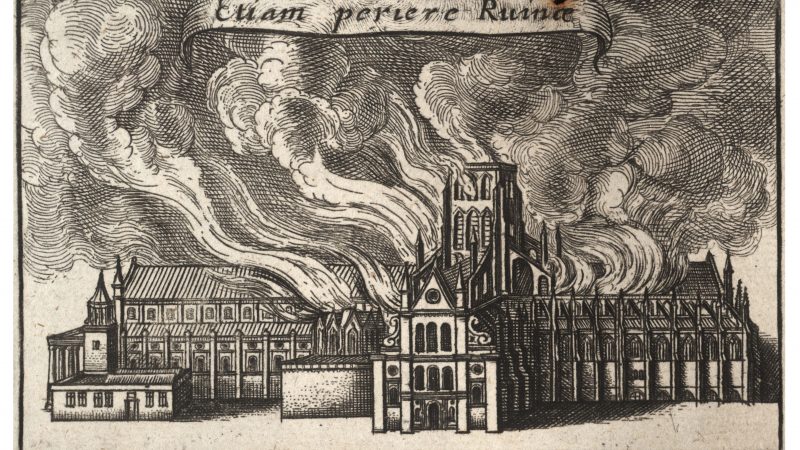
Illustration 4 – Hollar’s 1666 engraving of old St Paul’s burning.
So, there is much to arouse suspicion. Who could have been behind a plot? Contemporaries of the fire proposed a variety of conspirators. Thomas Vincent, for example, proposed that ‘it smelt of a Papish design’ (Milne, 1986 p.30) while others suggested that the fire was started by French and Dutch attacker since England was at war with France and Holland at the time.
Just two weeks earlier, for example, the English had burned West-Terschelling in Holland to the ground and also used fire ships to burn up to 170 Dutch Merchant Navy ships, actions that not only attest to the animosity between Holland and England but also to English skills in pyrotechnics, a field that includes an understanding of fireballs and flares.
That was not all for Pepys wrote of rumours ‘that there is plot in it and that the French had done it’ (ibid, p.60) and a Frenchman, Robert Hubert, confessed to starting the blaze, and was found guilty and executed in London in October 1666.
What do we know of Hubert? Born in Rouen, he was arrested in Essex on suspicion of fleeing England and confessed to the justice who examined him, Cary Harvey, that he had started the conflagration by firing Thomas Farriner’s house. He claimed that he had been recruited in 1665 in Paris as one of twenty-three conspirators who were to set fire to London and had been paid one pistol (equivalent to a gold coin with a value slightly less than a sovereign) with another 5 promised in the future.
He also stated that nothing was attempted that year because of the plague but that in summer 1666 he and two others, including one Stephen Peidloe, or Pie-de-Low, had gone to Sweden, returning to London at the end of August, and that on the night of 2 September Peidloe had taken him to Pudding Lane.
There, according to his statement, he put a lighted fireball of gunpowder, brimstone, and other flammable material on the end of a pole, pushing it through a window in Farriner’s house and waiting to see the building aflame before making off. His companions, meanwhile, according to his account, had already escaped.
Interestingly, other suspected arsonist s had been roughly handled or arrested both during the fire and shortly after it had ended. Amongst these was a ten-year-old boy who told Lord Lovelace how he and his family, abetted by a Dutchman, had started the blaze in Pudding Lane with fireballs.
Hubert was convicted of a felony at the city sessions in October on his own confession, though he had pleaded not guilty when first indicted. Was he guilty or not?
In support of his guilt is the fact that he was unerringly able to describe the appearance of Farriner’s House in Pudding Lane and also identify its whereabouts amongst the ruins.
He also confessed his guilt to a friend of his father, a French merchant named Graves, who claimed that he had known Hubert and Peidloe before the fire and believed them capable of the crime. Moreover, despite multiple suspects, Farriner, his son, and his daughter signed the true bill against Hubert who was hung on 27 October 1666.
Note that it was not until 15 years later, on 17 December 1681 that the captain of the Swedish ship that had brought Hubert to London gave testimony to a new inquiry. On this occasion the captain stated that his boat had arrived in London 2 days before the fire but that Hubert had only disembarked after the start of the fire.
Many contemporary commentators put their weight behind this testimony but why would the captain have waited 15 years to convey evidence of this significance concerning one of the gravest fires in history? Not only that, but evidence that undermines the guilty verdict reached in respect of Hubert’s culpability.
In fact, in a fascinating article on post-fire events, Jenner (2017, p.24) writes of the controls exercised on post-fire narratives with the ‘suppression not only of inflammatory rumours that it had been started by conspirators … but also, it seems, of all unauthorised reports of the inferno’.
These restrictions involved arresting those responsible for publishing and selling unlicensed books and broadsheets, the case for example of the publishers of the broadsheet announcing that ‘the Dutch, French and Jesuite are the formentors in this treacherous design ‘ (ibid, p.25). This censorship of the non-official narratives even led the Privy Council in 1667 to order the public burning of a pamphlet that offered the evidence presented to the Commons’ inquiry into the causes of the Fire (Dolan, 2001).
CUI BONO? – To Whom is it a Benefit?
The final question relates to who stood most to gain from the Great Fire of London. These gains included financial profits from rebuilding (whether as a landowner, architect or tradesperson, insurance broker or tax authority) as well as the development of a new and more beautiful city.
It certainly seems that people were motivated to act with extreme promptitude – or unseemly haste – after the last ashes were laid to rest on 7 September. For, just three days later, on 10 September, the City established a committee to consider its “recovery out of the … deplorable ruins’ (Journal of Common Counsel) and, on the same day, Henry Oldenburg, Secretary to the Royal Society, wrote to Robert Boyle that he had attended “many meetings of ye principals Cittizens, … who … discoursed almost of nothing, but of a survey of London, and a dessein for rebuilding, … wth Bricks, and large Streets.” (Oldenburg correspondence).
Then, on the fourth day after the fire, on 11 September, Christopher Wren presented his plan for the City to the King. Note that on 1 May 1666, before the fire, he had recommended that a dome should replace the crossing tower of St Paul’s cathedral, with estimates ordered on 27 August of that year.
Then, on 13 September, less than one week following the end of the fire, Charles II issued his Declaration which spoke of his desire for “a much more beautiful City,” and which promised that with the assistance of the Mayor and Aldermen a design would be set out in “a short time.”(His Majestie’s Declaration).
Things moved apace after this.
By 25 September, a little over a fortnight after the end of the fire, a committee was appointed to enquire into the cause of the fire and by 4 October, a little under one month since the start of the fire, a committee was appointed for the rebuilding of London. The Privy Council, Royal appointments included Christopher Wren, Hugh May and Sir Roger Pratt while the City appointments included Robert Hooke, Edward Jarman and Peter Mills. This administrative wizardry happened in a city devastated by fire and in a pre-Internet era. Could forethought have played a part perhaps?
There was much at stake. In terms of finances, it is estimated that 80% of London had been destroyed by the Great Fire with the value of the value of the destroyed property put at around £1.5 billion in today’s money, so the profits from rebuilding would have been substantial. Who stood to gain?
In terms of the liabilities for rebuilding, most Londoners lived as leaseholders, renting their homes from the owners and their leases required them to cover the full costs of any damage (and also to pay the rent for the full term of the lease, even if the property no longer existed). The trial and execution of Robert Hubert in October 1666, in making the fire an act of war, put the responsibility back onto the property owners but a parliamentary report issued in January 1667 concluded that the fire was not a malicious act and so responsibility once again fell on tenants.
Their obvious inability to cover the costs of rebuilding London led to the setting up of the Fire Courts, to better distribute the burden (Oxford National Dictionary of Biography, Farriner) but the burden of the rebuilding still fell on the mass of people. rather than just landowners, through new taxation introduced. For, in 1667, King Charless II ordered a new tax on coal arriving in London, a tax that was doubled in 1670.
So, you might say that the landowners and Crown benefited from the fire and the financing of new stone and brick buildings.
Other profits emerged from the new activity of insurance that arose in 1680 when the first insurance company, the ‘Fire Office’, was set up by Nicholas Barbon. The creation of other insurance companies followed so that by 1690 one in ten houses in London was insured.
What we discover then is the extent to which a number of people gained directly from the fire of London.
The King stood to have a new capital city built with funding coming from taxation; landowners could rely on tenants to foot the bill for rebuilding; and Wren experienced a new career as architect extraordinaire following the fire. In fact, the benefits bestowed on the King and Wren are so extraordinary that we sketch some details below.
CHRISTOPHER WREN
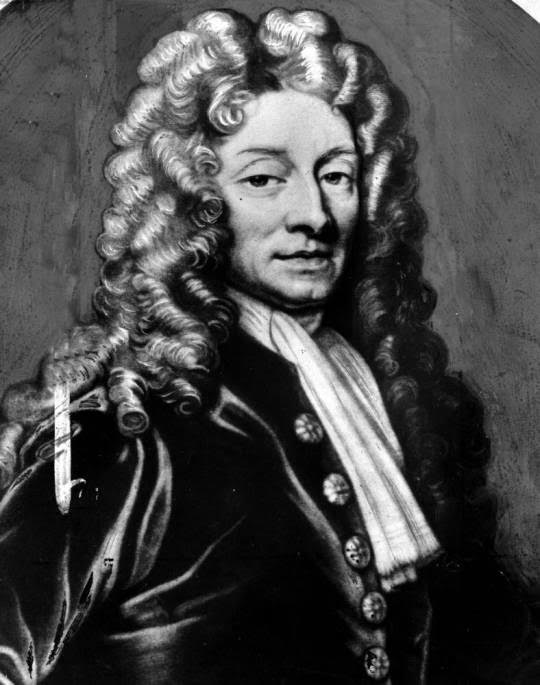
Illustration 5 – Christopher Wren
Before the fire, Wren’s forays into architecture had been limited to two commissions, one for the design of a Chapel at Pembroke College, one that had come from his uncle the Bishop of Ely, and a second for the design of the Sheldonian theatre in Oxford.
His background had been in mathematics and astronomy, not architecture and so in June 1655 he embarked on a ten month overseas trip to Paris, returning in March 1666, just sixth months before the Great Fire that provided his ‘big opportunity’ (Victoria and Albert style guide). This was his only journey abroad in the course of a long life spanning 90 years.
Although records of this single overseas journey are sparse—primarily one long letter from Wren himself—the two people that he expressly wished to meet, and undoubtedly met, were the French architect François Mansart and the Italian sculptor and architect G. L. Bernini, who arrived in Paris from Rome at the request of Louis XIV on 2 June 1665.
What is more, he viewed Jacques Lemercier’s church of the Sorbonne (1635-43) and the Val-de- Grâce by Francoise Mansart (1645-62), both domed-buildings, and fulfilled his aim of returning with ‘almost all France on paper’.
Back in England, in fact, he spoke of ‘daily conference with the best Artists’, French and Italian, and first-hand study of modern design and construction (Oxford National Dictionary of Biography, Wren).
This ten month stay in Paris proved extraordinarily timely since it provided Wren (illustration 5) with the apprenticeship in architecture that allowed him to assume the architectural responsibilities that came his way immediately after the Great Fire. There is evidence that he delegated much of the design of future buildings, for example in the design of St Paul’s Cathedral () and the City churches but some basic understanding of architecture would have been required even when directing the work of others.
KING CHARLES II
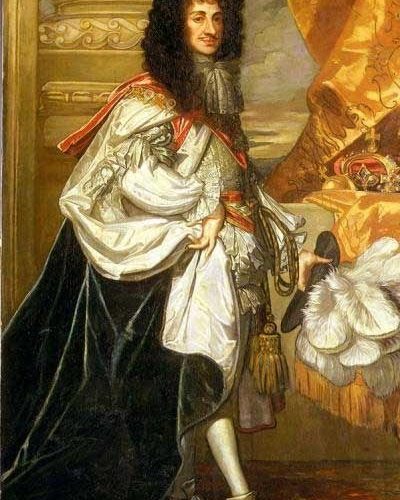
Illustration 6 – Charles II
Before assuming the throne, Charles spent nine years in exile, with the first few years of this at the French court with his Bourbon mother, Henrietta Maria. Following his departure from France in 1654, he spent a spell in the Holy Roman Empire, before settling in the Spanish Netherlands, a dominion of the King of Spain. He was to remain there until his restoration in 1660.
This period overseas gave Charles a taste for the latest European styles, and encouraged his use of foreign-trained artists and craftspeople who used flamboyant forms and rich materials (Victoria and Albert, Restoration style guide). In matters of personal dress, for example, he used a Parisian tailor, Sourceau, who had worked for him while he was in exile in France in the late 1940s.
So, it seems that the fire provided Charles (illustration 6) with the opportunity to convert London from the timber-framed city that it was to something closer to the cities he had been accustomed to during his period of exile.
CONCLUDING REMARKS
We have seen the care that Charles II took to ensure that post-Fire narratives accounts of the Fire conformed to that of the official narrative. Now, some 353 years since this event, we have been able to hold a light to the official story and allow a full and uncensored debate on the many anomalies in the official story.
ATTENTION READERS
We See The World From All Sides and Want YOU To Be Fully InformedIn fact, intentional disinformation is a disgraceful scourge in media today. So to assuage any possible errant incorrect information posted herein, we strongly encourage you to seek corroboration from other non-VT sources before forming an educated opinion.
About VT - Policies & Disclosures - Comment Policy



